Visiting Russia-IVShigeru Saito, MD, FACC, FSCAI, FJCC
|
|
|
|
As always I directly went to Cafe Pushkin to have late dinner, which was very crowded as compared to last year by good-appearance young Moscow people although it was already close to 12:00 midnight. I felt that the economy in Moscow was growing rapidly. After having late dinner, I checked in the historical hotel “Hotel Metropol”, where the past great leader of Soviet Union Vladimir Lenin announced the famous declaration of “Revolution in October” in 1907. That declaration was the beginning of the Socialistic Republic of Soviet Union. The hotel building is old and magnificent and seemed impossible for me to connect my computer with Internet. However, it was lucky that the high-speed WiFi network was available although only in the lobby area. After checking e-mails I went to bed. It was almost 1:30 AM.
June 09 Thursday, 2005
I waked up early at 5:00 AM. It was already 10:00 AM in Japan. As always I could not adjust myself to the time difference. I came down to the lobby, connected my computer with Internet and then uploaded the files on “Visiting Indonesia-I” of “Where is Dr. Saito?” to my website. I went to the gorgeous cafeteria inside the hotel to have breakfast. While I was sitting, Dr. Yves Louvard came and told to me, “We were looking for you. Already a car to the hospital is waiting in the backyard.” Since my role was from 2:00 PM and I was not yet ready for my lecture, I answered to him, “Do not mind. I will go later by myself by a taxi.”
|
|
|
This trip to Moscow was my 5th time visit. Professor B.G. Alekyan of Bakoulev National Cardiovascular Center invited me to “the 6th Moscow International Course on Endovascular Surgery of Congenital and Acquired Heart Diseases, Coronary and Vascular Pathology”, which is the biggest scientific meeting on Interventional Cardiology in whole Russia. I have been invited to this meeting since the 3rd meeting in June 1992. There are very famous European and US doctors but only I from Japan invited as Faculty members. This year we had those famous doctors as Dr. Louvard from France, Dr. Josef Ludwig and Dr. G. Biamino from Germany, Dr. Carlo Di Mario from United Kingdom, Dr. U. Sigwart from Switzerland, Dr. Gregg Stone from US, and so on. Every year I have delivered the lectures on 2 topics: “PCI on CTO lesions” and “PCI for AMI”. Thus, the title of my lecture this year was “Angioplasty for Chronic Total Occlusion - Tips and Tricks in 2005”. Bakoulev National Cardiovascular Center belongs to “Ministry of Health and Social Development of the Russian Federation” and “Russian Academy of Medical Sciences”, and its formal name is “Bakoulev Scientific Center for Cardiovascular Surgery”. They have the biggest number of PCI cases in Russia. Total case number for PCI last year was almost 500 there. The hospital building is huge and equipped with 6 catheter laboratories.
|
|
Moscow progressed very quickly in these 3 years after my 1st visit. The number of automobile cars increased, and we can see many new foreign nice cars these days. After crossing by the most expensive building in Moscow, I went to Bakoulev Cardiovascular Center. I could see a new big shopping mall, which I could not find last year, just before arriving at the hospital. Thus, I could see a lot of changes on the way from the hotel to the hospital, although the overwhelming building of Bakoulev Hospital is not changed.
I was very surprised to see a Japanese gentleman. He came to me and told, “Hello, Dr. Saito. I am Mr Inukai from ASAHI INTECC Corporation Europe. I heard that you were here. I came here to promote our sales for PCI guidewires in Russia. Very nice to see you.” He came from Japan and now is staying in Amsterdam to cover the sales of ASAHI INTECC Corporation in whole Europe. It was the 3rd time for me to meet with him. They are doing not big but steady business also in Russia.
|
|
The meeting was held in the big auditorium and conference rooms within the hospital. The live transmissions from the catheter laboratories on the 9th floor were sent through ISDN lines. Thus, images were not clear as compared in the other live demonstrations. Dr. Stone was very active to moderate the sessions with Dr. Di Mario. Although my lecture was scheduled around 2:00 PM, it was postponed to after 4:00 PM due to the live transmissions by Dr. Di Mario and Dr. Stone. Dr. Stone’s case was the patient with in-stent restenosis in a saphenous vein graft. It was finished without any problem by placing a drug-eluting stent. The case for Dr. Di Mario had a short total occlusion in the proximal LAD and a bifurcation narrowing in distal LCX with recent onset of effort angina. I expected that he would start from PCI to LAD. However, his strategy was so strange that he started from LCX. His procedure was very slow and long, and used many guidewires, 7 balloons and at least 3 stents for 1 bifurcation lesion. After spending long time, much contrast dye and X-ray exposure, a lot of materials and much money, the distal LCX was finally closed, although it was not shown in the transmission. After I heard the story from doctors in the catheter laboratories, I was very worrying about the patient’s condition. It was incredible. Since I got a little bit angry at this improper schedule change, I finished my presentation very quickly by skipping many slides while telling, “I am afraid whether I can do live cases after this lecture. So, I will finish my lecture quickly.”
|
|
After finishing my lecture, I went up to the catheter laboratories on the 9th floor, where Dr. Staferov Anton was waiting for me to show the cases possible assigned to me. Although they arranged 2 cases with CTO lesions for me, I did only 1 case because of the limitation in the schedule. The case I did had previous bypass surgery of LIMA-LAD, SVG-LCX and SVG-RCA. Two SVG grafts were occluded. Dr. Anton placed a DES stent in the proximal LCX narrowing in January 2005. He had a CTO lesion of at least 4 years in the proximal RCA. The anatomy distal to the occlusion was faintly visualized by the bridge collateral. I used the right femoral approach by using a 7-French guiding catheter. I wanted to use a 7-French AL 1.0 guiding catheter with side holes, but they had only a 7-French AL 2 guiding catheter without side holes. As I was afraid, the guiding catheter was too much deeply engaged in the proximal RCA. However, I had no other choice than continuing to use it. A reliable assistant Dr. Anton assisted me. I first took a Miracle-3 guidewire with a Transit microcatheter. However, the guidewire was too soft for the total occlusion that I could never advance it. Then, I exchanged the guidewire to a Conquest. Again, it was too soft. Next, I took a Miracle-12 guidewire, which was again not enough stiff to make a hole in the occlusion. Finally, I took a Conquest-Pro12 from my bag. I could advance it anywhere outside the vessel lumen. Somebody in the auditorium strongly claimed to stop the procedure. I told, “Why I have to stop the procedure? The patient has no chest pain or EKG changes.” And, I continued the procedure. The Conquest-Pro12 guidewire could anyway make an entry hole at the proximal cap of the occlusion. While keeping the Conquest-Pro12 in the position, I took the previous Miracle-12 guidewire. From the auditorium, Dr. Alekyan told me that the transmission would be finished soon.
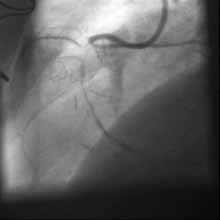 |
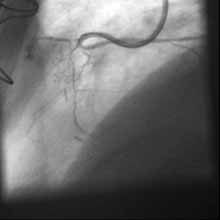 |
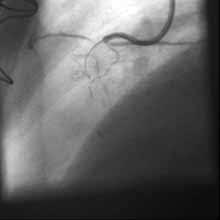 |
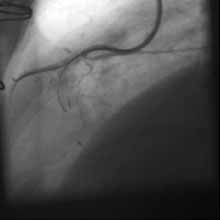 |
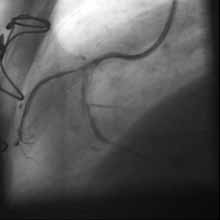 |
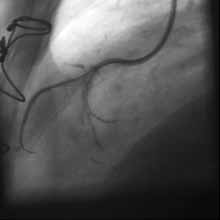 |
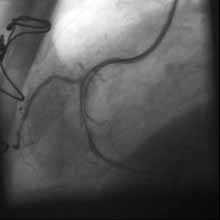 |
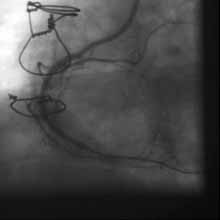 |
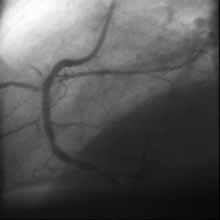 |
Then, I was successful to advance it into a big RV branch originating from the distal part of the occlusion. The transmission came back soon, since, I guess, many audiences strongly claimed to continue to watch my procedure. While keeping it in the branch, I navigated the previous Conquest-Pro12 guidewire to another small branch originating distal to the RV branch. Finally, I could successfully navigate the Miracle-12 guidewire into the distal true lumen. I heard a burst of applause from the audience. After balloon dilatation, I put a 3.0 x 33 mm CYPHER stent from the ostium of RCA. This whole procedure was finished within 30 minutes. Everybody was happy for the final result. I took a picture with my best assistant Dr. Anton and a beautiful assistant nurse to congratulate for this difficult but successful case, following the picture with fellow doctors. Although I had no chance to demonstrate my techniques on TRI, I was happy for the result.
|
Although Dr. Alekyan and the organizing committee arranged the tour to Bolshoi Theater to watch Opera that night for the Faculty members, I rejected it and went to a Japanese Sushi Bar near the hotel. The most interesting Sushi here is Black Caviar Sushi. Sushi is very popular in Moscow, and there are 160 Sushi bars in Moscow now. The chief chef was an Indonesian, who was trained in those famous Japanese Restaurants as “Nadaman” in Jakarta and “Inagiku” in Bali Island. He can speak Japanese, English, Russian as well as Indonesian.
|
|
After having light dinner in the Sushi Bar, I went to my favorite Russian Restaurant “Godunov”. I had a cup of Black Caviar and enjoyed folk live music there. Also, I found a beautiful Russian lady. After finishing the dinner in Godunov, I walked to the Red Square. Although it was already 10:00 PM, it was not dark outside. Since I was still in high tension after the successful PCI for CTO lesion, I was very surprised to find a signboard, where I could see “CTO”. After coming back to the hotel, I had drinking in the bar. Sparkling mineral water was from Georgia.
|
|
|
|
|
|
June 10 Friday, 2005
I waked up at 4:00 AM and came down to the lobby to connect my computer with Internet. After having breakfast, I checked out the hotel and went to the hospital. After I joined the round-table discussion on the treatment for AMI patients with Dr. Stone, Dr. Di Mario, Dr. Louvard, Dr. Alekyan and others between 8:30 and 10:00 AM, I came back to the downtown and had a short city tour. There are many beautiful buildings in Moscow.
|
|
|
|
|
|
|
|
|
Since I had to take LH 3185 flight for Frankfurt departing at 16:50 and the traffic in Moscow on Friday evening is very heavy, I had lunch in a Russian Restaurant on the way back to the Airport. I had Black Caviar, Russian Salad, Russian vegetable soup Bolshch and beef stew. The building of Moscow Airport is very old and narrow. It always takes long time to check in and pass the passport control. The departure of my flight was delayed by more than 1 hour as always. After 1 and half hours’ transit time in Frankfurt-Main International Airport, I was successfully transferred to NH 210 flight departing at 20:45 for Tokyo and finally arrived in Japan around 3:00 PM on June 11 Saturday, 2005.
|
|
|